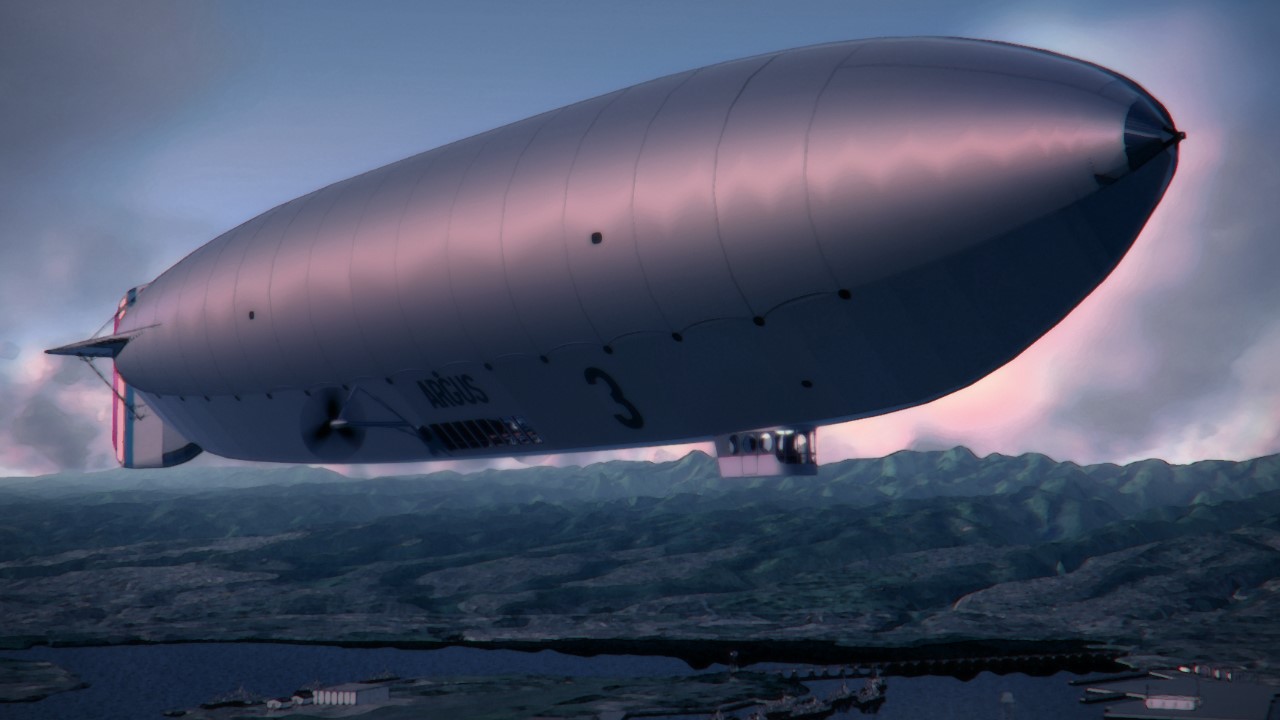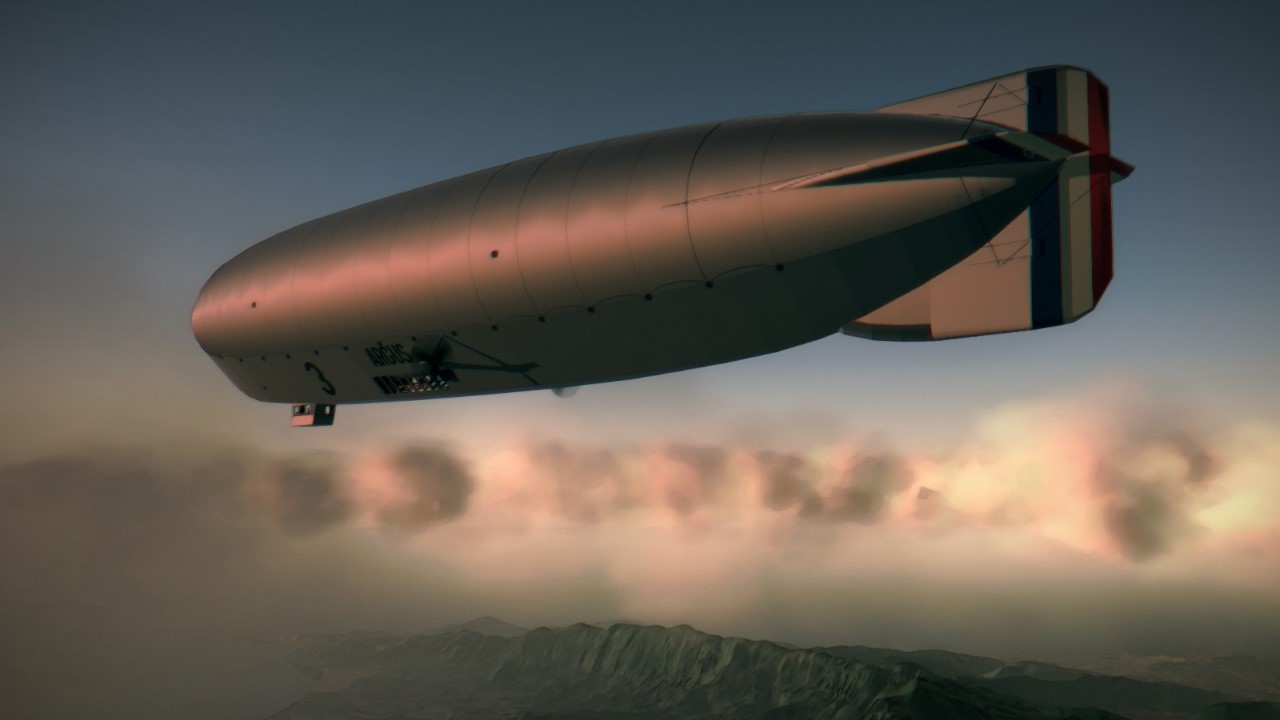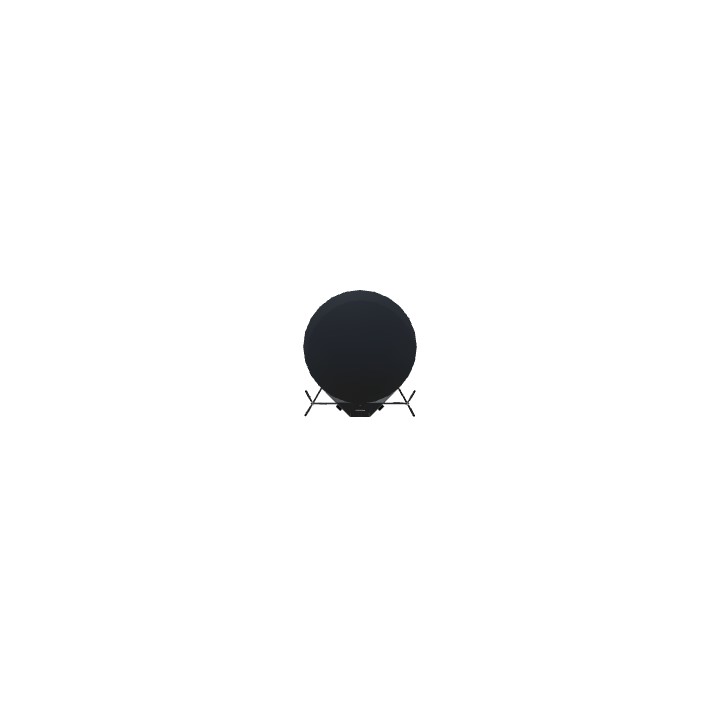
MCAS Argus was a patrol airship of Giant class commissioned with M.Corp Navy from 1929 to 1940, and recommissioned as a testbed from 1946 to 1955. It is currently on permanent display as a centerpiece in the Airship Museum.
Design and development:
MCAS Argus was designed in 1928 on the navy's request. Contract called for an airship with a maximum speed of no less than 70 knots, able to stay airborne for no less than 72h at a time and capable of deploying depth charges and naval mines.
To fulfill the requirements, M.Corp design buro has opted for a semi-rigid design. Due to far lower weight of its keel over the full framework of rigid airships, Argus could be equipped with more powerful engines, more fuel, and could still carry more payload.
Keel of the airship was laid in November of 1928, and the ship took its first flight in march of 1929, being commissioned into service in June the same year. It was followed by two more Giant class airships.
Design of MCAS Argus is typical of semi-rigid airships, with a solid frame underneath the envelope. Crew quarters, engine room, and fuel tanks, helium tanks and supplies are all stored in the frame under the envelope. Frame is covered by canvas and flush with the envelope.
Service history
Having entered service in 1929, it was put on patrol duty in the coastal areas. Its main role was to look for submarines, although more often it was tasked with search and rescue and counter-smuggling work. Five years into its service, its depth charge racks were removed to lighten up the airship, allowing it to reach altitude of 3000m with full tanks and up to 3300m with its tanks empty. Its role became ferrying high ranking officials, which it fulfilled until 1940 when it was conserved in its hangar for the duration of the Second World War. It was recommissioned after the war in its pre-war role of ferrying officials, though it was more and more often used for testing new technologies, including being the first airborne early warning radar system in history. It was finally decommissioned in 1955, conserved, and placed on permanent display in its 1934 layout (without depth charge racks) in 1988.
Controls:
- Throttle => Forward propulsion;
- Throttle + Brake => Backwards propulsion;
- VTOL => Forward ballonet (up => increase lift at front end);
- TRIM => Rear ballonet (up => increase lift on the rear end);
- VTOL + Trim => Increase/decrease buoyancy;
- Roll => Rudder;
- Pitch => Elevators.
Features:
- Huge size. It's literally 100m long.
- Realistic performance, including service ceiling and max speed.
- Detailed gondola interior.
- Working, readable instruments (instructions below).
- Two furnished rooms, and office and a dining/map room.
- Five camera views so you don't miss any detail.
- Realistic, though not historic controls layout.
- Swinging light fixtures.
Instructions:
For better experience,
Set a greater field of view. Paste this into the dev console: >>CameraManagerScript..SetCameraFov 80. Replace "80" with your prefered field of view. Save it for later use.
Instruments:
Gondola is fitted with working, accurate instruments. You can disable HUD (F9) while using this build.
Altimeter
Every notch is 100m. Altimeter goes to 4000m though ship cannot reach that high.
Airspeed indicator
Every notch is 10km/h.
Attitude indicator
Attitude indicator only shows pitch angle, as airships aren't supposed to roll and are too stable to roll over. Every notch is _°.
Compass
Compass is placed right behind the rudder wheel. Every notch is 10°, with marked North and South, and thicker notches for East and West. Medium thickness notches indicate SE, NE, SW, NW.
Flying:
The airship should slowly lift off on its own. If it doesn't, move VTOL and Trim up a little to add buoyancy to both ends. In flight, control attitude via elevators and trim the airship by adjusting VTOL and Trim (inflating/deflating forward and rear ballonet). You will need to add buoyancy as the altitude increases. Ballonets are large and take some time to inflate/deflate.
Gallery:









Pictures provided by Leehopard and MisterT.
For UTILITY category of the challenge due to its secondary SaR role.
Enjoy.
Specifications
Spotlights
- realSavageMan 5.4 years ago
General Characteristics
- Successors 1 airplane(s)
- Created On Windows
- Wingspan 52.5ft (16.0m)
- Length 332.8ft (101.4m)
- Height 64.7ft (19.7m)
- Empty Weight N/A
- Loaded Weight 23,608lbs (10,708kg)
Performance
- Power/Weight Ratio 0.571
- Horse Power/Weight Ratio 0.011
- Wing Loading 3.0lbs/ft2 (14.5kg/m2)
- Wing Area 7,972.0ft2 (740.6m2)
- Drag Points 1919
Parts
- Number of Parts 872
- Control Surfaces 0
- Performance Cost 2,655







Lol i exepct this thing to have MCAS
Mcas A n g u s
So cute
@Sockdragger Thank you. I'm glad you've enjoyed the little details, I was wondering if anyone will notice them when I was building it.
The cup of tea at the radio operator's station did it for me. Congratulations on a truely remarkable built
Somehow this is mobile friendly!
@Planemaker1012 I'm glad you like it. Half of the building process here was shaving off excess parts and tweaking functionality. I too was playing on a second-hand laptop at the time, and the goal is to make it not lag even on my device.
forgot to mention it has pre 1.10-interior
runs really well on my second hand laptop! also below 900 parts is amazing, i expected maybe 1000 or 2000. veri nice
@EternalDarkness It just has a nice feeling when you look at it. To my wallpaper it goes
@Fish83828 I'm glad you like it.
First photo looks like art
@RedAndGreenAmongus a lot of effort went into reducing the part count. I'm glad it was worth it.
damn this is mobile friendly even though it has an interior. My phone runs it like an average save
@CanadianAircraftBuilder original was by my buddy Authros, I watched it being made, so easily recognized it.
@CanadianAircraftBuilder it was that really well built twin by a bronze user. You gave it quite a praise. It was a copy that intentionally bypassed successor system.
@DuskV yes. The engines themselves would be in a room next to the intakes, and would deliver power to the propellers via shafts.
b i g c y l i n d e r
@EternalDarkness Lol imagine this being a gunship.
@Sobolllo I'm glad you like it.
Amazing
@EternalDarkness ooh
@21212123 I have used some tricks to reduce part count.
@SimpleHelper thanks :)
wow, so much detail with no lag at all, very great job